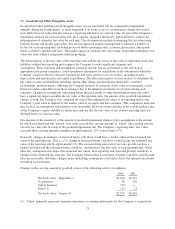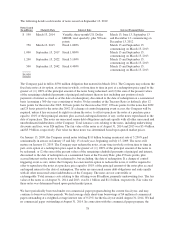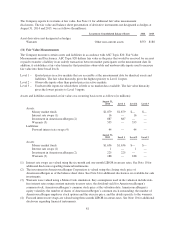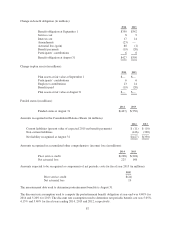Walgreens 2014 Annual Report Download - page 90
Download and view the complete annual report
Please find page 90 of the 2014 Walgreens annual report below. You can navigate through the pages in the report by either clicking on the pages listed below, or by using the keyword search tool below to find specific information within the annual report.
Assets measured at fair value on a nonrecurring basis were as follows (in millions):
August 31,
2014 Level 1 Level 2 Level 3
Assets:
Alliance Boots call option $— $— $— $—
August 31,
2013 Level 1 Level 2 Level 3
Assets:
Alliance Boots call option $839 $— $— $839
The call option was valued using a Monte Carlo simulation. Key assumptions used in the valuation include
expected term, Walgreens equity value, the value of Alliance Boots and the potential impacts of certain
provisions of the Purchase and Option Agreement dated June 18, 2012, by and among the Company, Alliance
Boots and AB Acquisitions Holdings Limited. The option was amended, and exercised, on August 5, 2014,
resulting in a new fair value determination that resulted in a loss on the option of $866 million.
The Company reports its debt instruments under the guidance of ASC Topic 825, Financial Instruments, which
requires disclosure of the fair value of the Company’s debt in the footnotes to the consolidated financial
statements. See Note 9 for further details.
(12) Commitments and Contingencies
The Company is involved in legal proceedings and is subject to investigations, inspections, audits, inquiries and
similar actions by governmental authorities, arising in the normal course of the Company’s business, including
the matters described below. Legal proceedings, in general, and securities and class action litigation, in
particular, can be expensive and disruptive. Some of these suits may purport or may be determined to be class
actions and/or involve parties seeking large and/or indeterminate amounts, including punitive or exemplary
damages, and may remain unresolved for several years. From time to time, the Company is also involved in legal
proceedings as a plaintiff involving antitrust, tax, contract, intellectual property and other matters. Gain
contingencies, if any, are recognized when they are realized. The results of legal proceedings are often uncertain
and difficult to predict, and the costs incurred in litigation can be substantial, regardless of the outcome. The
Company believes that its defenses and assertions in pending legal proceedings have merit, and does not believe
that any of these pending matters, after consideration of applicable reserves and rights to indemnification, will
have a material adverse effect on the Company’s consolidated financial position. However, substantial
unanticipated verdicts, fines and rulings do sometimes occur. As a result, the Company could from time to time
incur judgments, enter into settlements or revise its expectations regarding the outcome of certain matters, and
such developments could have a material adverse effect on its results of operations in the period in which the
amounts are accrued and/or its cash flows in the period in which the amounts are paid.
On a quarterly basis, the Company assesses its liabilities and contingencies for outstanding legal proceedings and
reserves are established on a case-by-case basis for those legal claims for which management concludes that it is
probable that a loss will be incurred and that the amount of such loss can be reasonably estimated. Substantially
all of these contingencies are subject to significant uncertainties and, therefore, determining the likelihood of a
loss and/or the measurement of any loss can be complex. With respect to litigation and other legal proceedings
where the Company has determined that a loss is reasonably possible, the Company is unable to estimate the
amount or range of reasonably possible loss in excess of amounts reserved due to the inherent difficulty of
predicting the outcome of and uncertainties regarding such litigation and legal proceedings. The Company’s
assessments are based on estimates and assumptions that have been deemed reasonable by management, but that
may prove to be incomplete or inaccurate, and unanticipated events and circumstances may occur that might
cause the Company to change those estimates and assumptions. Therefore, it is possible that an unfavorable
resolution of one or more pending litigation or other contingencies could have a material adverse effect on the
82
























